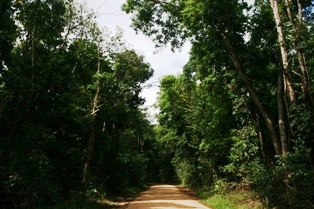Kutini-Payamu (Iron Range) National Park facts for kids
Quick facts for kids Iron Range National ParkQueensland |
|
|---|---|
|
IUCN Category II (National Park)
|
|

Iron Range National Park
|
|
| Nearest town or city | Weipa |
| Established | 1977 |
| Area | 346 km2 (133.6 sq mi) |
| Managing authorities | Queensland Parks and Wildlife Service |
| Website | Iron Range National Park |
| See also | Protected areas of Queensland |
Kutini-Payamu (also known as Iron Range) is a special national park in Queensland, Australia. It's about 1,940 kilometers northwest of Brisbane. You can find it 100 kilometers east of Weipa in the Cape York Peninsula. This park is home to amazing wildlife and has an interesting history. It includes the Iron Range (Lockhart River Resources Reserve) and the Aboriginal Shire of Lockhart River. During World War II, many Australian Army units were based here.
Contents
Amazing Birds of Iron Range
The Iron Range National Park is a very important place for birds. It's part of a huge area called the McIlwraith and Iron Ranges Important Bird Area (IBA). This area is recognized by BirdLife International because it protects many rare birds.
One special bird found here is the buff-breasted buttonquail. This bird is in danger of disappearing. The park is one of the few places where it lives. You can also spot southern cassowaries here. These large, colorful birds are usually found in other areas, but a group lives in this park.
Other beautiful birds you might see include lovely fairywrens and silver-crowned friarbirds. There are also many types of honeyeaters, like the yellow, yellow-spotted, white-streaked, and banded honeyeaters. The white-browed robin also makes its home here.
A unique parrot, the eclectus parrot subspecies Eclectus roratus macgillivrayi, lives only in the Iron and McIlwraith Ranges. It's a truly special place for birdwatching!
History of Iron Range during World War II
Iron Range played a big role during World War II. It became an important location for airbases. These bases helped protect Australia during the war.
Building the Airbases
In March 1940, an expert named Val Augenson checked the area. He was looking for a good spot to build an emergency landing ground for the Royal Australian Air Force (RAAF). He found that the Iron Range area was perfect for an all-weather airfield.
Later, in April 1942, an American officer named Walter Maiersperger flew over the area. He was looking for coastal airfields suitable for B-26 Marauder planes. These planes were used by the United States Army Air Forces.
On May 28, 1942, another inspection happened. Pilot Officer Trench from the RAAF and American officers looked at the area near Portland Roads. They found that while Portland Roads had good docks, there was no space for an airfield nearby. However, they discovered a large, suitable area west of Iron Range and east of the Claudie River. This spot was perfect for building several airfields.
Soon after, in June 1942, American and Australian teams arrived. They came by ship from Townsville to Portland Roads. The US 46 Engineer General Service Regiment and the 26 Operational Base Unit RAAF quickly set up radio communication.
It was amazing how fast they worked! Within just three months, American engineers built two long runways, each 7,000 feet (about 2,130 meters) long. They also created 21 kilometers of sealed taxiways. By November 1942, the 90th Bombardment Group arrived with their B-24D Liberator planes. These planes were based about 16 kilometers inland from Portland Roads.
Military Units at Iron Range
Many different military units were stationed at Iron Range during World War II. These units included:
- Australian Army and Air Force groups.
- United States Army Air Forces units.
- Medical teams, like the 3rd Portable Surgical Hospital.
- Engineer regiments, like the 46 Engineer Regiment, who built the airfields.
- Supply and transport companies.
- Coastal Artillery units to defend the area.
- Weather squadrons and communication centers.
- Civilian groups, like the Allied Works Council, also helped with construction.
All these groups worked together to support the war effort from this important base in Queensland.
Images for kids
See also
 In Spanish: Parque nacional Montes de Hierro para niños
In Spanish: Parque nacional Montes de Hierro para niños



